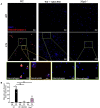Cigarette smoke-induced gasdermin D activation in bronchoalveolar macrophages and bronchial epithelial cells dependently on NLRP3
- PMID: 36045672
- PMCID: PMC9421433
- DOI: 10.3389/fimmu.2022.918507
Cigarette smoke-induced gasdermin D activation in bronchoalveolar macrophages and bronchial epithelial cells dependently on NLRP3
Abstract
Chronic pulmonary inflammation and chronic obstructive pulmonary disease (COPD) are major health issues largely due to air pollution and cigarette smoke (CS) exposure. The role of the innate receptor NLRP3 (nucleotide-binding domain and leucine-rich repeat containing protein 3) orchestrating inflammation through formation of an inflammasome complex in CS-induced inflammation or COPD remains controversial. Using acute and subchronic CS exposure models, we found that Nlrp3-deficient mice or wild-type mice treated with the NLRP3 inhibitor MCC950 presented an important reduction of inflammatory cells recruited into the bronchoalveolar space and of pulmonary inflammation with decreased chemokines and cytokines production, in particular IL-1β demonstrating the key role of NLRP3. Furthermore, mice deficient for Caspase-1/Caspase-11 presented also decreased inflammation parameters, suggesting a role for the NLRP3 inflammasome. Importantly we showed that acute CS-exposure promotes NLRP3-dependent cleavage of gasdermin D in macrophages present in the bronchoalveolar space and in bronchial airway epithelial cells. Finally, Gsdmd-deficiency reduced acute CS-induced lung and bronchoalveolar space inflammation and IL-1β secretion. Thus, we demonstrated in our model that NLRP3 and gasdermin D are key players in CS-induced pulmonary inflammation and IL-1β release potentially through gasdermin D forming-pore and/or pyroptoctic cell death.
Keywords: NLRP3 inflammasome; cigarette smoke; gasdermin D; lung; mice.
Copyright © 2022 Huot-Marchand, Nascimento, Culerier, Bourenane, Savigny, Panek, Serdjebi, Le Bert, Quesniaux, Ryffel, Broz, Riteau, Gombault and Couillin.
Conflict of interest statement
The authors declare that the research was conducted in the absence of any commercial or financial relationships that could be construed as a potential conflict of interest.
Figures








Similar articles
-
Cigarette smoke extract induces pyroptosis in human bronchial epithelial cells through the ROS/NLRP3/caspase-1 pathway.Life Sci. 2021 Mar 15;269:119090. doi: 10.1016/j.lfs.2021.119090. Epub 2021 Jan 16. Life Sci. 2021. PMID: 33465393
-
Cigarette smoke and extracellular Hsp70 induce secretion of ATP and differential activation of NLRP3 inflammasome in monocytic and bronchial epithelial cells.Cytokine. 2020 Nov;135:155220. doi: 10.1016/j.cyto.2020.155220. Epub 2020 Jul 28. Cytokine. 2020. PMID: 32736335
-
The Nucleotide-Binding Oligomerization Domain-Like Receptor Family Pyrin Domain-Containing 3 Inflammasome Regulates Bronchial Epithelial Cell Injury and Proapoptosis after Exposure to Biomass Fuel Smoke.Am J Respir Cell Mol Biol. 2016 Dec;55(6):815-824. doi: 10.1165/rcmb.2016-0051OC. Am J Respir Cell Mol Biol. 2016. PMID: 27447246
-
Regulation and Function of the Nucleotide Binding Domain Leucine-Rich Repeat-Containing Receptor, Pyrin Domain-Containing-3 Inflammasome in Lung Disease.Am J Respir Cell Mol Biol. 2016 Feb;54(2):151-60. doi: 10.1165/rcmb.2015-0231TR. Am J Respir Cell Mol Biol. 2016. PMID: 26418144 Free PMC article. Review.
-
Polyphenols, flavonoids and inflammasomes: the role of cigarette smoke in COPD.Eur Respir Rev. 2022 Jun 14;31(164):220028. doi: 10.1183/16000617.0028-2022. Print 2022 Jun 30. Eur Respir Rev. 2022. PMID: 35705209 Free PMC article. Review.
Cited by
-
The Pyroptotic and Nonpyroptotic Roles of Gasdermins in Modulating Cancer Progression and Their Perspectives on Cancer Therapeutics.Arch Immunol Ther Exp (Warsz). 2023 May 31;71(1):14. doi: 10.1007/s00005-023-00678-9. Arch Immunol Ther Exp (Warsz). 2023. PMID: 37258998 Review.
-
NLRP6 controls pulmonary inflammation from cigarette smoke in a gut microbiota-dependent manner.Front Immunol. 2023 Dec 11;14:1224383. doi: 10.3389/fimmu.2023.1224383. eCollection 2023. Front Immunol. 2023. PMID: 38146368 Free PMC article.
-
Pyroptosis-Related Genes as Diagnostic Markers in Chronic Obstructive Pulmonary Disease and Its Correlation with Immune Infiltration.Int J Chron Obstruct Pulmon Dis. 2024 Jun 27;19:1491-1513. doi: 10.2147/COPD.S438686. eCollection 2024. Int J Chron Obstruct Pulmon Dis. 2024. PMID: 38957709 Free PMC article.
-
PANoptosis: Mechanism and Role in Pulmonary Diseases.Int J Mol Sci. 2023 Oct 19;24(20):15343. doi: 10.3390/ijms242015343. Int J Mol Sci. 2023. PMID: 37895022 Free PMC article. Review.
-
Distinct Pro-Inflammatory Mechanisms Elicited by Short and Long Amosite Asbestos Fibers in Macrophages.Int J Mol Sci. 2023 Oct 13;24(20):15145. doi: 10.3390/ijms242015145. Int J Mol Sci. 2023. PMID: 37894824 Free PMC article.
References
Publication types
MeSH terms
Substances
LinkOut - more resources
Full Text Sources
Medical
Molecular Biology Databases

